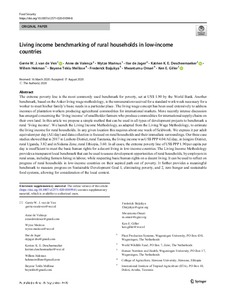| dc.contributor.author | van de Ven, G.W. |
| dc.contributor.author | de Valença, A. |
| dc.contributor.author | Marinus, W. |
| dc.contributor.author | de Jager, I. |
| dc.contributor.author | Descheemaeker, K.K. |
| dc.contributor.author | Hekman, W. |
| dc.contributor.author | Mellisse, B.T. |
| dc.contributor.author | Baijukya, F. |
| dc.contributor.author | Omari, M. |
| dc.contributor.author | Giller, K. |
| dc.date.accessioned | 2020-12-03T11:43:32Z |
| dc.date.available | 2020-12-03T11:43:32Z |
| dc.date.issued | 2020 |
| dc.identifier.citation | van de Ven, G.W., de Valença, A., Marinus, W., de Jager, I., Descheemaeker, K.K., Hekman, W., ... & Giller, K.E. (2020). Living income benchmarking of rural households in low-income countries. Food Security, 1-21. |
| dc.identifier.issn | 1876-4517 |
| dc.identifier.uri | https://hdl.handle.net/20.500.12478/7006 |
| dc.description.abstract | The extreme poverty line is the most commonly used benchmark for poverty, set at US$ 1.90 by the World Bank. Another benchmark, based on the Anker living wage methodology, is the remuneration received for a standard work week necessary for a worker to meet his/her family’s basic needs in a particular place. The living wage concept has been used extensively to address incomes of plantation workers producing agricultural commodities for international markets. More recently intense discussion has emerged concerning the ‘living income’ of smallholder farmers who produce commodities for international supply chains on their own land. In this article we propose a simple method that can be used in all types of development projects to benchmark a rural ‘living income’. We launch the Living Income Methodology, as adapted from the Living Wage Methodology, to estimate the living income for rural households. In any given location this requires about one week of fieldwork. We express it per adult equivalent per day (AE/day) and data collection is focused on rural households and their immediate surroundings. Our three case studies showed that in 2017 in Lushoto District, rural Tanzania, the living income was US$ PPP 4.04/AE/day, in Isingiro District, rural Uganda, 3.82 and in Sidama Zone, rural Ethiopia, 3.60. In all cases, the extreme poverty line of US$ PPP 1.90 per capita per day is insufficient to meet the basic human rights for a decent living in low-income countries. The Living Income Methodology provides a transparent local benchmark that can be used to assess development opportunities of rural households, by employers in rural areas, including farmers hiring in labour, while respecting basic human rights on a decent living. It can be used to reflect on progress of rural households in low-income countries on their aspired path out of poverty. It further provides a meaningful benchmark to measure progress on Sustainable Development Goal 1, eliminating poverty, and 2, zero hunger and sustainable food systems, allowing for consideration of the local context. |
| dc.description.sponsorship | University of Wageningen |
| dc.description.sponsorship | Bill & Melinda Gates Foundation |
| dc.format.extent | 1-21 |
| dc.language.iso | en |
| dc.subject | Rural Communities |
| dc.subject | Income Generation |
| dc.subject | Poverty |
| dc.subject | Sustainable Agriculture |
| dc.subject | Sustainable Development |
| dc.subject | Livelihoods |
| dc.subject | East Africa |
| dc.title | Living income benchmarking of rural households in low-income countries |
| dc.type | Journal Article |
| cg.contributor.crp | Agriculture for Nutrition and Health |
| cg.contributor.crp | Climate Change, Agriculture and Food Security |
| cg.contributor.affiliation | Wageningen University and Research Centre |
| cg.contributor.affiliation | World Wildlife Fund |
| cg.contributor.affiliation | Hawassa University |
| cg.contributor.affiliation | International Institute of Tropical Agriculture |
| cg.coverage.region | Africa |
| cg.coverage.region | East Africa |
| cg.coverage.country | Ethiopia |
| cg.coverage.country | Tanzania |
| cg.coverage.country | Uganda |
| cg.coverage.hub | Eastern Africa Hub |
| cg.researchtheme | Natural Resource Management |
| cg.identifier.bibtexciteid | VANDEVEN:2020 |
| cg.isijournal | ISI Journal |
| cg.authorship.types | CGIAR and developing country institute |
| cg.iitasubject | Livelihoods |
| cg.iitasubject | Smallholder Farmers |
| cg.iitasubject | Socioeconomy |
| cg.journal | Food Security |
| cg.notes | Open Access Article; Published online: 28 Sept 2020 |
| cg.accessibilitystatus | Open Access |
| cg.reviewstatus | Peer Review |
| cg.usagerightslicense | Creative Commons Attribution 4.0 (CC BY 0.0) |
| cg.targetaudience | Scientists |
| cg.identifier.doi | https://dx.doi.org/10.1007/s12571-020-01099-8 |
| cg.iitaauthor.identifier | Gerrie van de Ven: 0000-0001-5693-0280 |
| cg.iitaauthor.identifier | katrien descheemaeker: 0000-0003-0184-2034 |
| cg.iitaauthor.identifier | Frederick Baijukya: 0000-0003-2586-2013 |
| cg.iitaauthor.identifier | Ken E Giller: 0000-0002-5998-4652 |
| cg.futureupdate.required | No |

